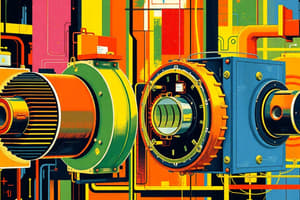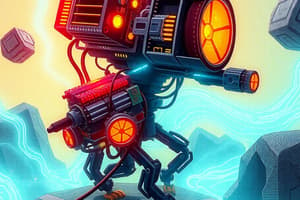Podcast
Questions and Answers
What is a drawback of DC brushed servo motors?
What is a drawback of DC brushed servo motors?
- Longer lifespan
- Lower maintenance requirements
- Higher efficiency
- Brush wear (correct)
Which type of servo motor usually offers higher efficiency and longer lifespan?
Which type of servo motor usually offers higher efficiency and longer lifespan?
- Miniature servo motors
- Linear servomotors
- DC brushed
- BLDC (correct)
In servo motors, what is used for position sensing?
In servo motors, what is used for position sensing?
- Integrated sensors (correct)
- Proportional-Integral-Derivative correction
- Motor output regulation
- PWM communication
Which industry would most likely prefer low-cost brushed DC servo motors for their applications?
Which industry would most likely prefer low-cost brushed DC servo motors for their applications?
What is a common application of servo motors in the movie and entertainment production industry?
What is a common application of servo motors in the movie and entertainment production industry?
What is a key advantage of brushless servos over brushed servos?
What is a key advantage of brushless servos over brushed servos?
Which industry commonly uses servo motors for precise thrust vectoring in aircraft engines?
Which industry commonly uses servo motors for precise thrust vectoring in aircraft engines?
How do brushless servos create torque without physical contact between parts?
How do brushless servos create torque without physical contact between parts?
Which of the following is NOT a common application of servo motors mentioned in the text?
Which of the following is NOT a common application of servo motors mentioned in the text?
What is a significant role played by servo motors in the automotive industry according to the text?
What is a significant role played by servo motors in the automotive industry according to the text?
Flashcards are hidden until you start studying
Study Notes
Understanding Servo Motors
Servo motors are specialized electric motors designed with precision control in mind. Unlike conventional DC or AC motors that mostly focus on delivering torque and speed, servos combine powerful actuation with fine positioning capabilities—making them indispensable components across industrial automation, robotics, and consumer electronics. Let's explore how these unique machines function and their numerous applications.
Construction of Servo Motors
A typical servo motor consists of three main parts: the motor itself, some form of positional feedback sensor, and a controller. The electromagnetic core within the motor produces rotational forces based on applied electrical currents, similar to other types of motors. However, what sets servos apart is the addition of a built-in encoder (or resolver) that continuously provides position feedback data to its attached controller, enabling real-time corrections if needed.
Types of Servo Motors
There exist various configurations of servo motors distinguished by construction details such as:
- Type: Brushed DC or brushless AC (BLDC)
- DC brushed models have been historically popular due to simplicity and cost; however, brush wear has been a drawback
- BLDC versions offer higher efficiency, longer lifespan, and lower maintenance requirements
- Size: Ranging from miniature to large-scale, depending on application needs
- Shaft type: Rotary or linear servomotors
The choice between brushed DC and BLDC often boils down to the desired usage scenario. For instance, small hobbyist projects might favor low-cost brushed DC models, whereas more sophisticated applications usually opt for BLDC variants for performance benefits and longevity.
How Servo Motors Work
When servos receive commands via serial communication protocols like PWM (Pulse Width Modulation), they convert this information into precise angular displacement. A closed loop control system automatically adjusts internal parameters to achieve accurate tracking of desired positions under various external conditions.
This process involves essential functions such as:
- Position sensing through integrated sensors
- Comparison of actual angle versus commanded value
- Error calculation
- Proportional-Integral-Derivative (PID)-based correction
- Motor output regulation
Through constant iterations of the above steps, the servo motor attains and maintains high accuracy in reaching specified positions while remaining sensitive to environmental changes.
Applications of Servo Motors
Due to their versatility, servo motors find applications in an extensive range of industries including:
- Robotics: Providing smooth motion and delicate handling capability to robotic arms and manipulators
- Manufacturing: Automating assembly lines, machinery operations, and packaging processes
- Medical equipment: Assisting surgical procedures, imaging devices, and patient monitoring systems
- Consumer appliances: Controlling speed and direction of home appliances like washing machines and vacuums
- Unmanned vehicles: Guiding drones, autonomous cars, and unmanned ground vehicles
- Model aircraft and boats: Piloting radio-controlled craft
- Gaming industry: Powering arcade game controllers and virtual reality equipment
- Movie and entertainment production: Enhancing special effects and animatronics
In conclusion, servo motors shine due to their remarkable ability to deliver controlled movement alongside unparalleled accuracy and responsiveness required in many modern technical fields. As technology advances, we can expect new innovations pushing boundaries in both motor design and application possibilities.
Studying That Suits You
Use AI to generate personalized quizzes and flashcards to suit your learning preferences.





